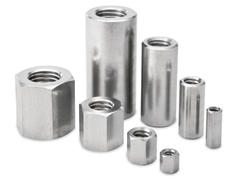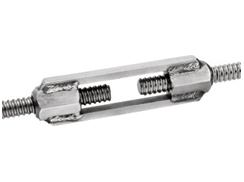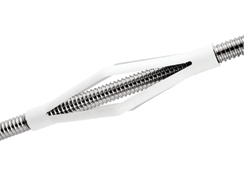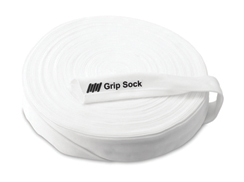BENEFITS
High strength thread rolled stainless steel bars
Proven high bond strength
Easily cut on site without any damage to thread form
Unique corrosive resistant product
6 metre standard lengths
Can be cut or joined to size
Superior ductility for seismic activity
APPLICATIONS
Rock bolts
Soil nails
Docks and harbours
Building and bridge cross ties
Ground anchors
Holding down bolts
Coastal defence walls, slopes and slabs
Technical Information Ultimate Tensile Stress [minimum]
750 N/mm² 0.2% proof stress [minimum] 650 N/mm² Minimum elongation 15% Typical lengths 6m Straightness 2 in 1000 Available Grades 304 / 316

Ref Nom. Dia. C.S.A 0.2% proof load Ultimate tensile load Weight per metre mm mm² kN kN Kg/m GB10 10 62 40 46 0.49 GB12 12 91 54 64 0.73 GB16 16 167 108 124 1.30 GB20 20 261 170 196 2.10 GB22 22 322 203 235 2.60 GB24 24 378 246 283 2.90 GB27 27 492 320 368 3.90 GB30 30 596 388 446 4.70 GB33 33 737 480 552 5.75 GB36 36 873 568 653 7.00 GB39 39 1037 674 776 8.25 GB42 42 1197 778 896 9.50 GB45 45 1388 903 1038 10.90 GB48 48 1562 1016 1168 12.40
MANUFACTURING PROCESS
The high strength Grip-Bar® is made from cold drawn bar feedstock. It benefits from superior strength, whilst retaining the elevated ductility associated with stainless steel. Grip-Bar® is manufactured in 6m fully threaded lengths or by special order, with a bespoke thread on the ends of the bar. All the Grip-Bar® range of threaded products utilise the thread rolling principle, which benefits from not removing any material from the bar whilst generating the coarse thread. It is in principle a cold forging process, and hence the grain flow caused by this process improves the strength of the thread relative to that of a cut thread of the same size.
CORROSIVE CONSIDERATIONS
The selection of the correct grade of stainless steel must take account of the following features
The environment
Structural requirements
Maintenance
Life of structure
Surface finish
Factors, which may influence the selection within an environment, are temperature, pollutants, humidity and presence of chloride ions. The strength of the bar to be used is a structural matter to be decided by the project designer. In general it is reasonable to use grade 304 for most non-marine applications, however highways and marine structures generally call for grade 316 because of high chloride concentrations. Duplex grade 1.4462 can be used in high chloride environments for increased resistance to stress corrosion, pitting and crevice corrosion.
BOND
The development of the Grip-Bar® thread has over the years been supported by research, both by Stainless UK and at the University of Sheffield. Bond tests in accordance with BS 8110-type 2 bond reinforcing bar have shown that the Grip-Bar® thread provides a bond well in excess of that required.
Further research has been completed to investigate the performance of Grip-Bar® in a rock bolting environment with varying free and bonded lengths.
On each occasion the performance significantly out performed reinforcing bar comparators and both systems are in excess of the codes minimum recomendations.
SITE PERFORMANCE
Grip-Bar® is produced using a cold rolled thread which not only enhances the strength of the bar, but also provides a robust, self cleaning and user friendly thread which is easy to use on construction sites. The coarse pitch thread is less susceptible to galling than the traditional metric thread; the large pitch significantly speeds up assembly. The large flank angle on this bespoke thread design ensures that the crown of the thread is supported and will withstand significant site abuse and still remain serviceable.
FITTINGS
All the fittings have been designed to provide a strength of anchorage equal to the theoretical minimum required by the threaded bar.
Fittings are made as small as possible to ensure that the strength of the Grip-Bar® can fully be utilised, by selecting the smallest cored hole for the application, saving on drilling time, reducing the size of drilling plant required, both resulting in the optimum cost solution.
Couplers, load nuts and lock nuts are stocked in grade 316 stainless steel only.

GB Dia Load Nut - GBLN Lock Nut - GBN Coupler - GBCR Plate Washer GB Dia AF Length Weight AF Length Weight Dia. Length Weight Width Thickness Weight mm mm Kg mm mm Kg mm mm Kg mm mm Kg GB10 17 18 0.02 17 9 0.01 19 41 0.06 100 x 100 8 0.62 GB10 GB12 19 20 0.03 19 10 0.02 19 51.5 0.07 100 x 100 8 0.62 GB12 GB16 24 26 0.06 24 13 0.03 25 64 0.14 100 x 100 8 0.62 GB16 GB20 30 32 0.12 30 16 0.06 30 76 0.23 125 x 125 10 1.22 GB20 GB22 36 35 0.23 36 17 0.12 33 85 0.32 150 x 150 10 1.74 GB22 GB24 36 38 0.21 36 19 0.11 36 91 0.41 150 x 150 10 1.74 GB24 GB27 42 44 0.35 42 23 0.18 41 104 0.69 150 x 150 10 1.74 GB27 GB30 46 48 0.45 46 24 0.22 45 107 0.79 200 x 200 12 3.75 GB30 GB33 50 60 0.65 50 27 0.29 50 115 1.07 210 x 210 15 5.20 GB33 GB36 56 66 0.93 56 29 0.41 55 122 1.34 225 x 225 20 7.99 GB36 GB39 60 68 1.08 60 32 0.51 59 130 1.67 250 x 250 20 9.87 GB39 GB42 65 70 1.32 65 34 0.64 64 137 2.04 250 x 250 20 9.87 GB42 GB45 70 72 1.58 70 36 0.79 68 145 2.48 300 x 300 30 21.42 GB45 GB48 75 76 1.93 75 38 0.96 73 152 2.95 300 x 300 30 21.42 GB48
COMPARISON OF GRIP-BAR® AGAINST THREADED REINFORCEMENT BAR
Traditional methods of rock anchoring have involved the use of reinforcement bar with a threaded section. This system has suffered from a number of disadvantages which the use of Grip-Bar® helps overcome.
TENSILE STRENGTH
Reinforcement bar to BS 6744 has a proof strength of 500N/mm². To produce a thread on this bar requires reducing the bar section with a consequent reduction in strength. Grip-Bar® is manufactured from bar with a proof strength of around 600N/mm² which after being work hardened by thread rolling gives a minimum proof strength of 650 N/mm².
BOND STRENGTH
Comparative testing carried out by the University of Sheffield has shown that across a range of grout strengths, Grip-Bar® has bond strength up to first slip of at least 2.8 times that of equivalent reinforcement bar.
THREAD STRENGTH
Threading a reinforcement bar involves cutting a fine thread into the material which disrupts the surface and can make installing fixings more difficult. The course thread on Grip- Bar® is cold rolled which hardens the surface making fixings easier to apply.
FLEXIBLE INSTALLATION
With reinforcement bars, the threaded end has a fixed specified length. Variations on site may require changes to embedment length. This requires reforming the thread off site causing delays and possible thread damage. Grip-Bar® is fully threaded and can but cut to length on site without damage.
NUTS AND COUPLERS
Load nuts and couplers have been designed to provide a strength of anchorage equal to the theoretical minimum required by the threaded bar. Lock nuts are for locking purposes only.

TURNBUCKLE
To be used for adjusting the tension or length of a bar system.

LANTERN SPACERS
Centralisation of a single bar within a bore hole enables an even flow of grout around the bar.

GRIP SOCK
A flexible sock which fits over the anchor bar. As it is filled with grout it expands into cracks and holes.

PLATE WASHERS
Manufactured either flat or dished to suit up to 20 degree misalignment. Dished plates are supplied with a hemi washer to suit.

HOMING CAP
Can be manufactured in either stainless steel or nylon. The cap keeps the bar end central in the bottom of the hole.

WIRE ROPE
Can be used for securing rock netting.

EYE NUT
To be fitted to the end of the bar for passing rock netting wire through and many other uses.

GROUT
Chemical mortars and accessories for fixing Grip-Bar anchors into concrete and masonry.


